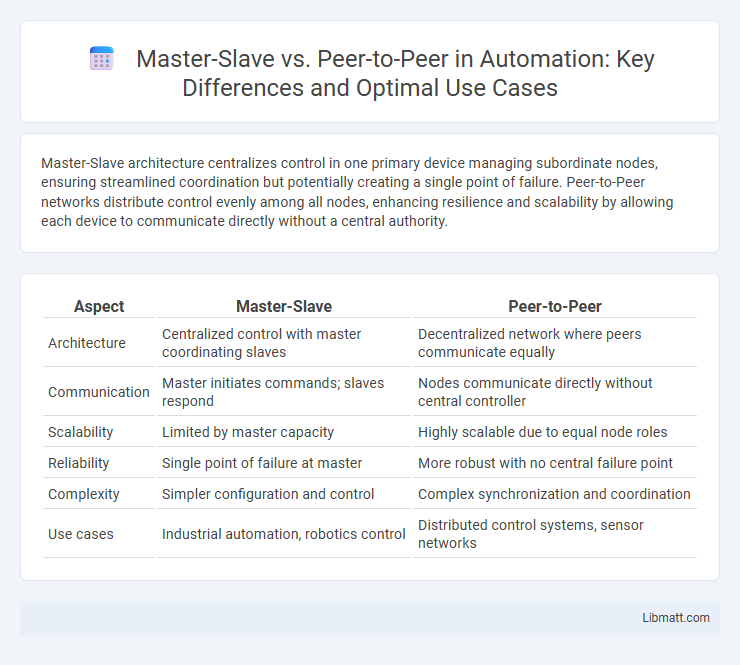Master-Slave architecture centralizes control in one primary device managing subordinate nodes, ensuring streamlined coordination but potentially creating a single point of failure. Peer-to-Peer networks distribute control evenly among all nodes, enhancing resilience and scalability by allowing each device to communicate directly without a central authority.
Table of Comparison
| Aspect | Master-Slave | Peer-to-Peer |
|---|---|---|
| Architecture | Centralized control with master coordinating slaves | Decentralized network where peers communicate equally |
| Communication | Master initiates commands; slaves respond | Nodes communicate directly without central controller |
| Scalability | Limited by master capacity | Highly scalable due to equal node roles |
| Reliability | Single point of failure at master | More robust with no central failure point |
| Complexity | Simpler configuration and control | Complex synchronization and coordination |
| Use cases | Industrial automation, robotics control | Distributed control systems, sensor networks |
Introduction to Network Architectures
Master-Slave and Peer-to-Peer are fundamental network architectures that define how devices communicate and share resources. In a Master-Slave network, one central device controls communication and resource allocation, ensuring organized and hierarchical management. Peer-to-Peer networks enable direct interaction between devices, promoting decentralization, equal authority, and collaborative data exchange without a central coordinator.
Defining Master-Slave Model
The Master-Slave model is a communication architecture where one device, the master, controls and coordinates several subordinate devices called slaves, which execute commands without independent decision-making. This centralized system enhances synchronization and simplifies management but can create a single point of failure, impacting overall network reliability. Understanding this model helps you design networks requiring strict control and hierarchical command structures.
Defining Peer-to-Peer Model
The Peer-to-Peer (P2P) model is a decentralized network architecture where each node, or peer, functions both as a client and a server, sharing resources and responsibilities equally without relying on a central authority. Unlike the Master-Slave model, where the master node controls and coordinates slave nodes, P2P distributes tasks and data directly among peers, enhancing scalability and fault tolerance. Your applications leveraging P2P networks benefit from increased robustness and efficient resource utilization through this balanced communication structure.
Architecture Comparison: Hierarchy vs Equality
Master-Slave architecture is defined by a hierarchical structure where the master controls communication and processing tasks, while slaves follow commands, ensuring centralized management and predictable performance. Peer-to-Peer architecture, by contrast, promotes equality with nodes acting as both clients and servers, enabling decentralized data sharing and collaborative resource utilization. This fundamental difference impacts scalability, fault tolerance, and communication complexity within distributed systems.
Communication and Data Flow
Master-Slave communication follows a hierarchical structure where the master controls data flow and coordinates tasks, ensuring synchronized and predictable exchanges between devices. Peer-to-Peer communication allows each node to act as both a sender and receiver, enabling decentralized and flexible data flow with no single point of control. Your choice between these models affects network efficiency, latency, and fault tolerance based on the required communication dynamics.
Scalability and Flexibility
Master-Slave architectures often face scalability limitations due to a single controller managing multiple nodes, creating bottlenecks as the network grows. Peer-to-Peer systems enhance scalability by distributing control across all nodes, enabling seamless expansion without centralized constraints. Flexibility is also higher in Peer-to-Peer models since each node can independently join, leave, or perform functions without hierarchical dependency.
Fault Tolerance and Reliability
Peer-to-peer networks exhibit higher fault tolerance and reliability by distributing tasks across multiple nodes, ensuring system functionality despite individual node failures. Master-slave architectures depend heavily on the master node, creating a single point of failure that reduces overall system reliability. Redundancy in peer-to-peer models enhances network resilience, whereas master-slave setups require complex failover mechanisms to maintain operational continuity.
Use Cases and Applications
Master-Slave architectures are commonly used in industrial automation, database replication, and embedded systems where centralized control and synchronization are critical. Peer-to-Peer networks excel in decentralized applications such as file sharing, blockchain technology, and collaborative platforms, enabling direct communication between nodes without a central authority. The choice between these models depends on requirements for control hierarchy, fault tolerance, and scalability in distributed systems.
Advantages and Disadvantages
Master-Slave architecture offers centralized control, simplifying coordination and fault detection, but risks a single point of failure and limited scalability. Peer-to-Peer systems enhance resilience and scalability by distributing tasks among equal nodes, though they introduce complexity in synchronization and consistency management. Choosing between these models depends on specific application requirements for control, fault tolerance, and network structure.
Choosing the Right Architecture
Choosing the right architecture depends on the specific requirements of system control and communication complexity. Master-Slave architecture provides centralized control, ensuring easier synchronization and management in environments where one node governs, while Peer-to-Peer models offer distributed control, enhancing scalability and fault tolerance in dynamic networks. Evaluating factors such as latency sensitivity, fault tolerance needs, and network size guides the decision between Master-Slave and Peer-to-Peer architectures for optimal performance.
Master-Slave vs Peer-to-Peer Infographic

 libmatt.com
libmatt.com